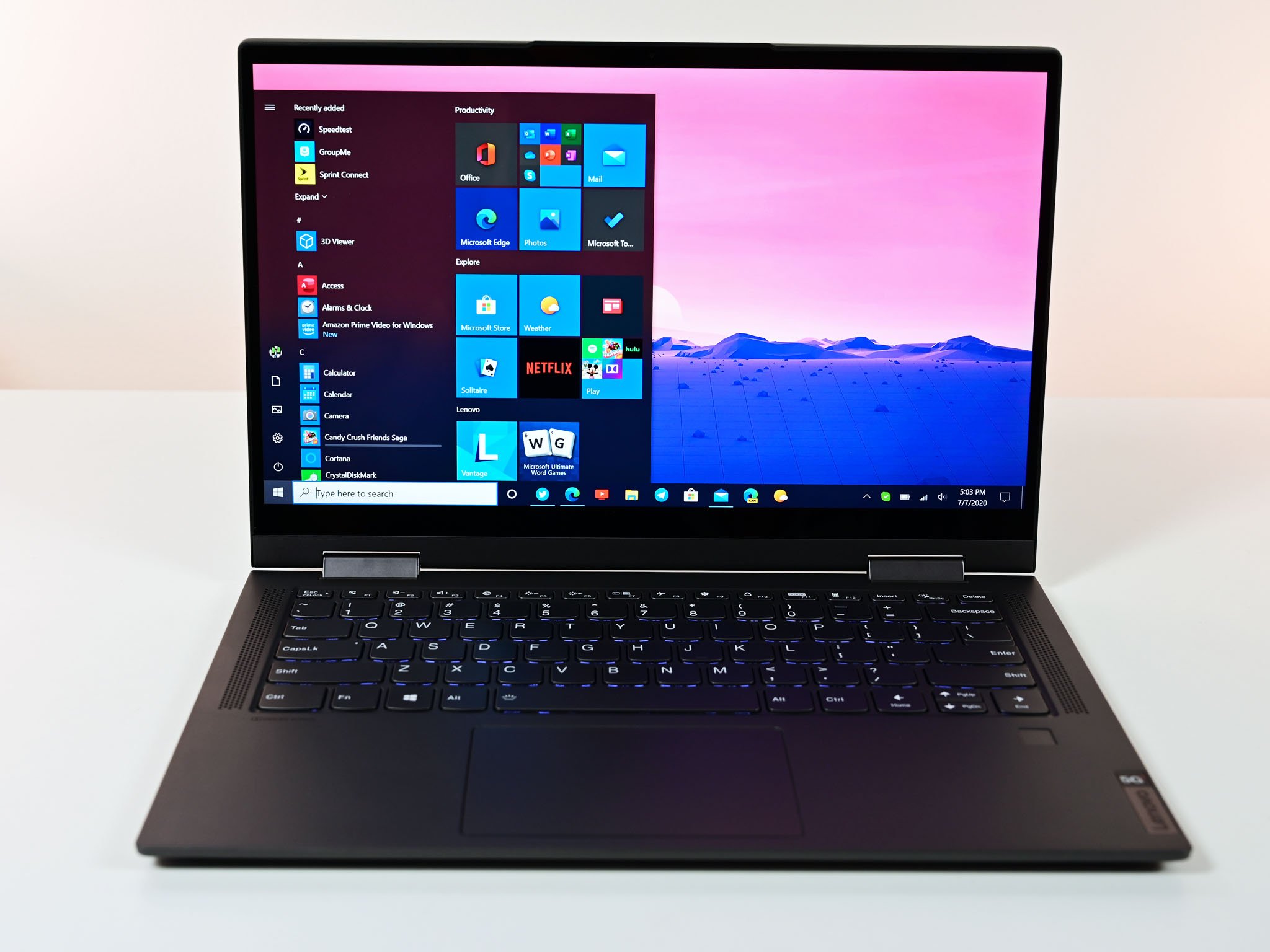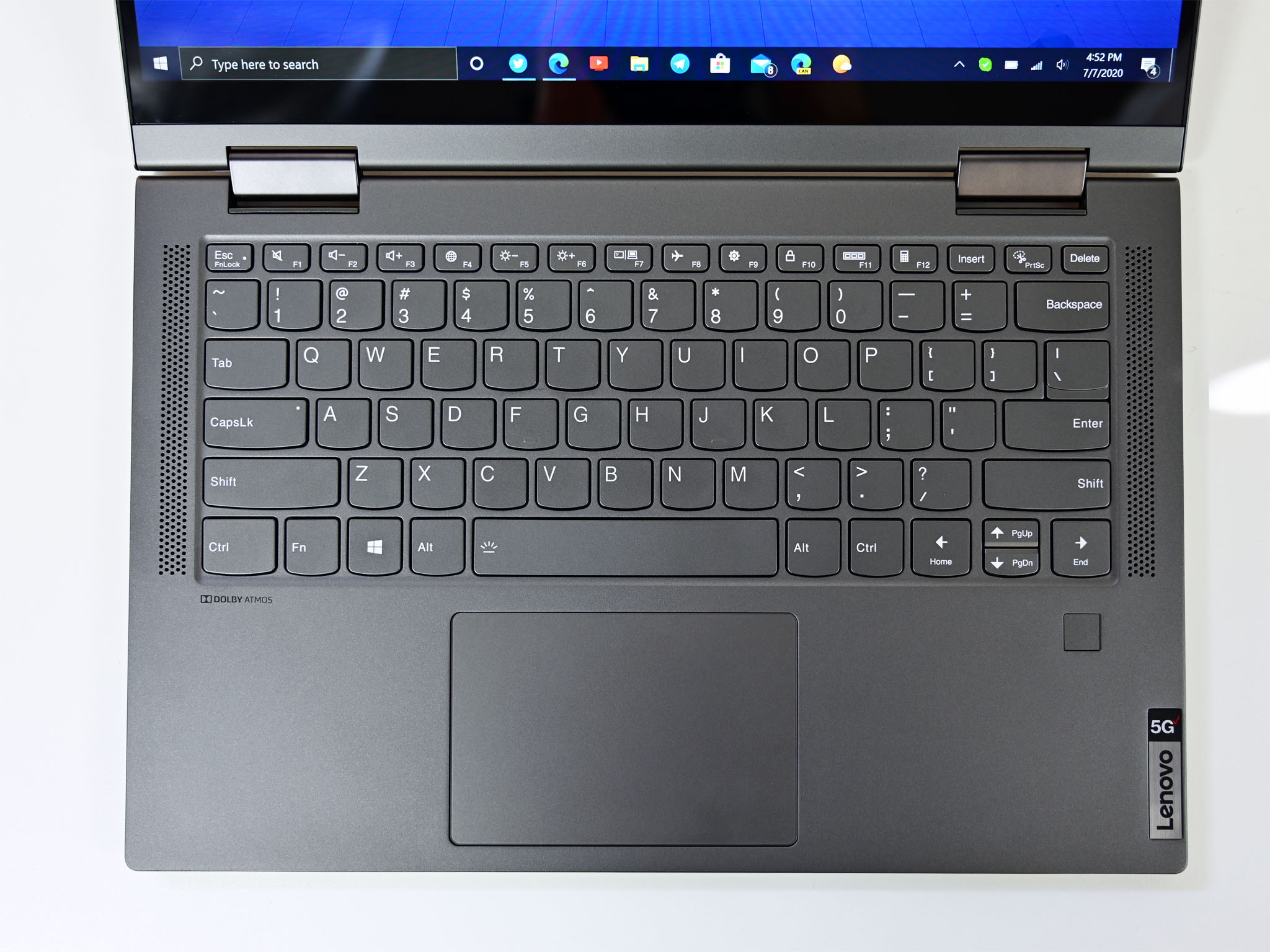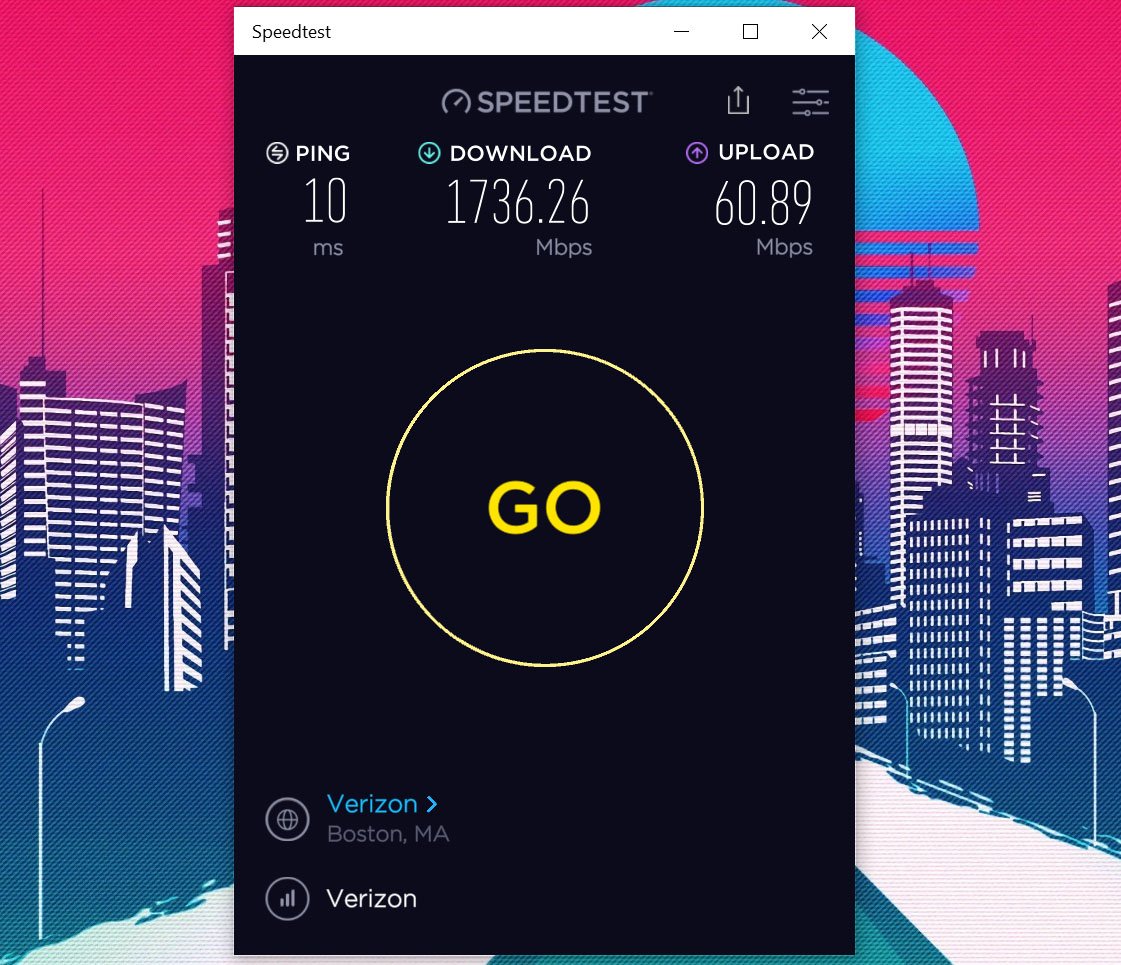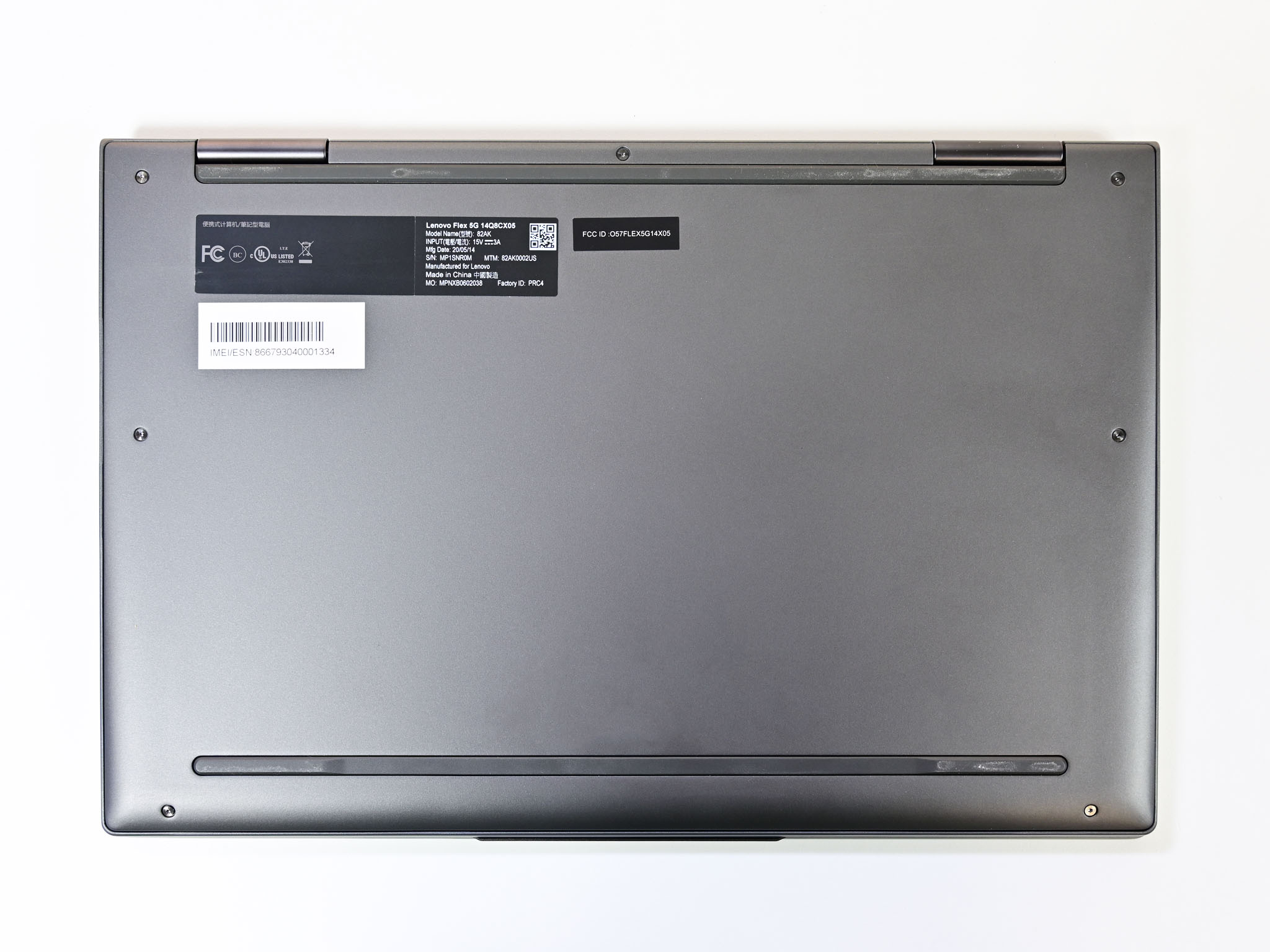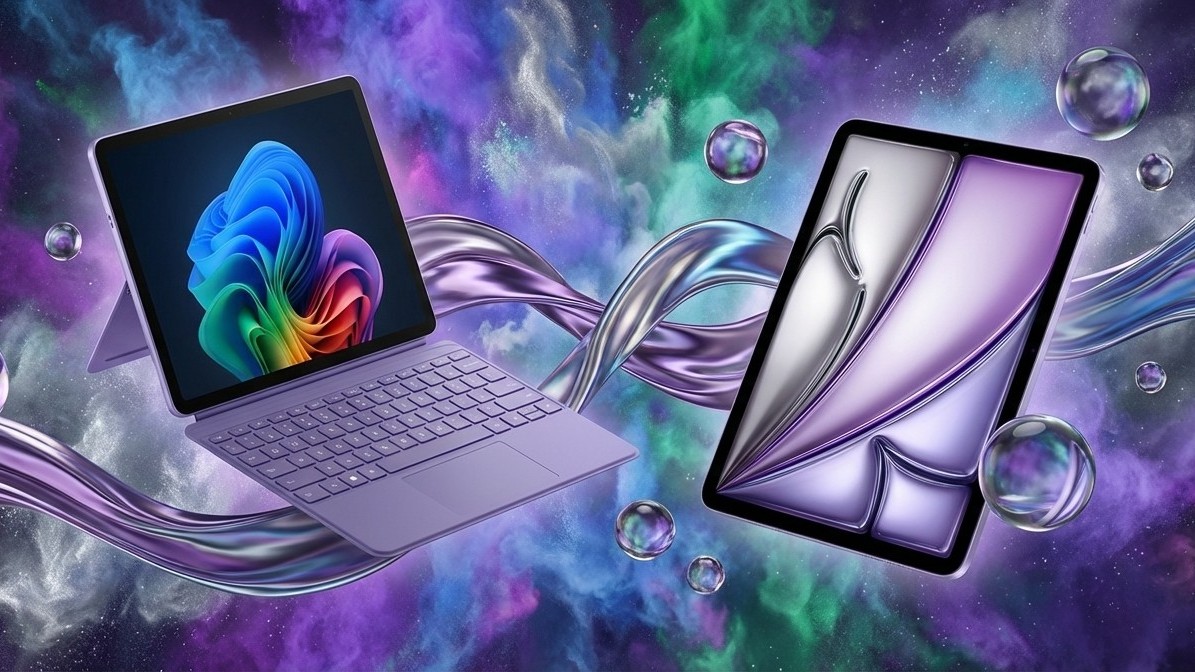The evolution of Windows 10 on ARM has been an interesting one for the last few years. Like any new category, it has taken time for the always-connected PCs to find their niche. While Surface Pro X finally put Microsoft's stamp on the technology, it is Lenovo who is taking it even further by being the first (and currently only) Windows 10 PC with built-in 5G connectivity.
Putting aside what the hype around next-gen mobile connectivity, Lenovo's take on the Flex 5G is surprisingly better than I had expected. Of course, its high asking price, no doubt due to Qualcomm's "5G tax" makes it a hard sell for anyone who doesn't have deep pockets. But none of that means it's not a great mobile solution either.
Here is where the Lenovo Flex 5G shines, and what can still be improved.
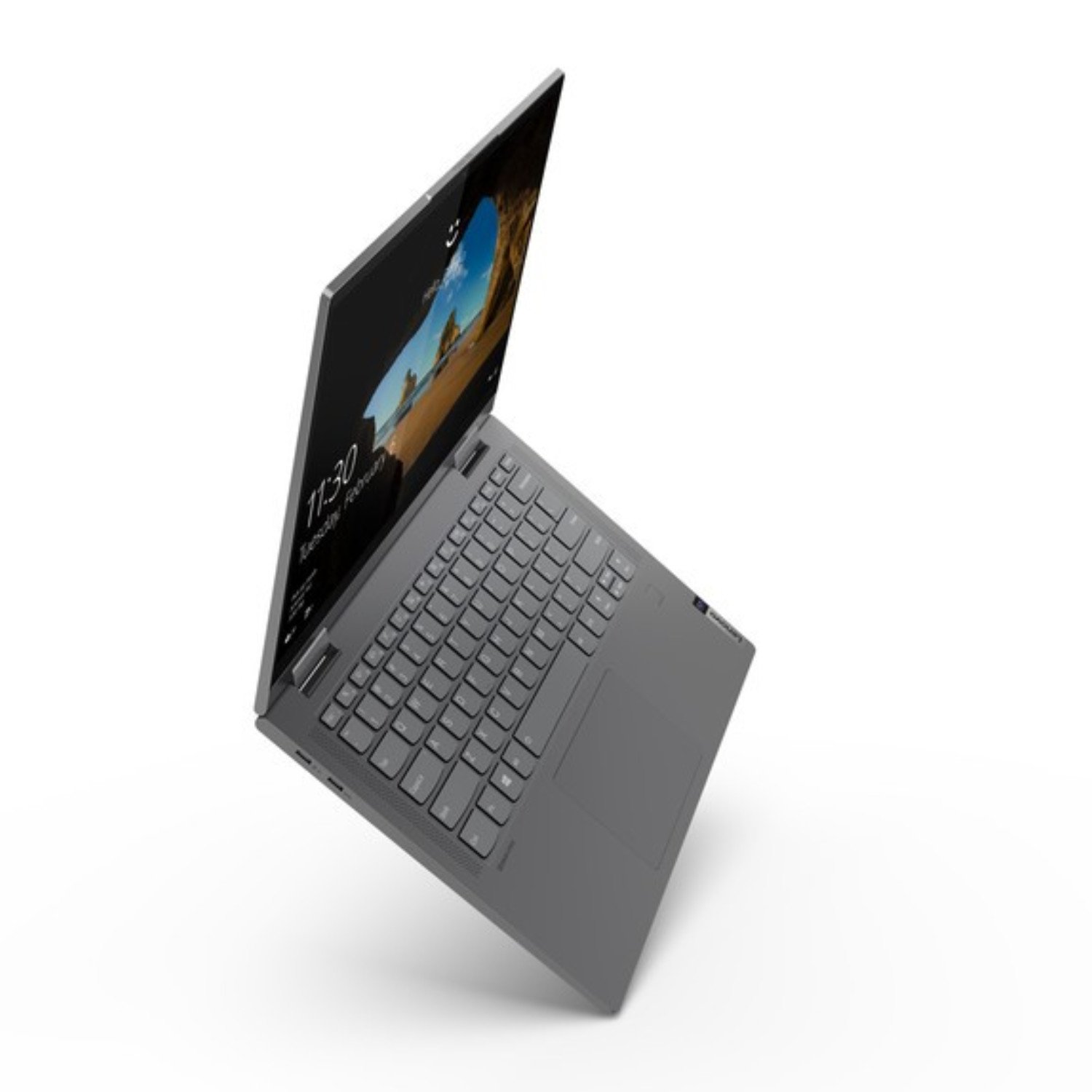
Bottom line: Lenovo is the first to market with a 5G-enabled, always-connected Windows 10 PC. While 5G is overhyped, its potential is evident in this laptop. Even without 5G, excellent battery life, display, and performance make it a unique solution for mobile workers everywhere. But with the higher cost, it's hard to recommend the Flex 5G for all but wealthy early adopters who live on the edge.
Pros
- Unlocked 4G and 5G SIM + eSIM
- Extreme battery life, always on
- Excellent design
- Larger, improved display
- Good performance
Cons
- Expensive "5G tax"
- No hibernate, odd low battery behavior
- Very glossy screen
- No Wi-Fi 6
Fit for light computing
Lenovo Flex 5G design, specs, and features
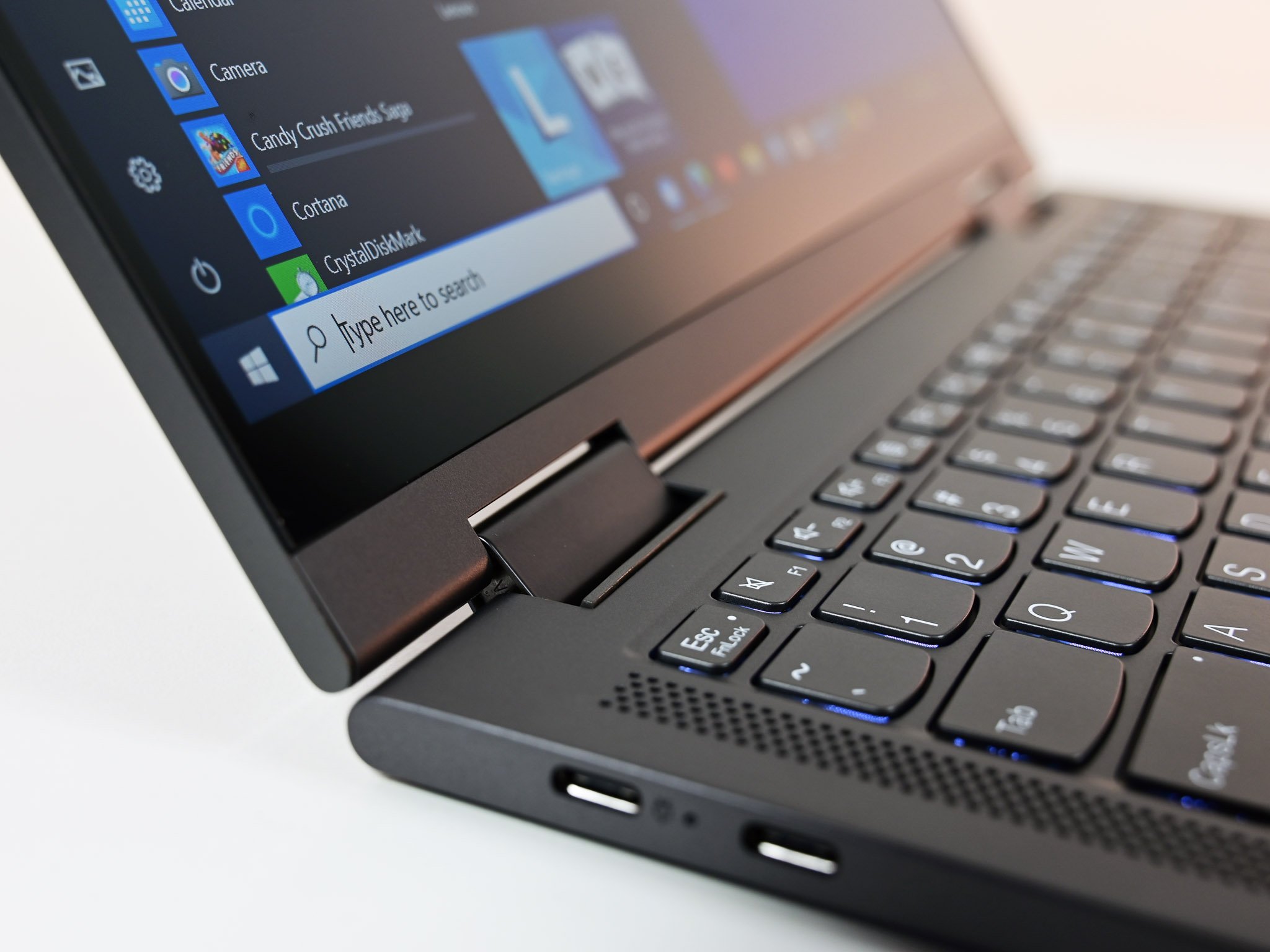
The Flex 5G borrows heavily from Lenovo's previous ARM-based PC the Yoga C630, which was released in late 2018. At the time, we gave the Yoga C630 high praise due to the long battery life, overall flexibility, and is one of the first ARM PCs with 8GB of RAM.
Lenovo went on to release the decent Yoga C640, dumping Qualcomm for Intel. But that was only short-lived as back in mid-2019, Lenovo and Qualcomm had teamed up for "Project Limitless", a collab to deliver the first 5G PC to market sometime in 2020. Project Limitless became the Flex 5G, which is sold directly by Lenovo and through its US partner with Verizon Wireless.
I expected the Flex 5G to be the same as the Yoga C630, but with the bonus of 5G connectivity. It turns out, Flex 5G is much more of refinement – and overall improvement – over Lenovo's last attempt at ARM.
All the latest news, reviews, and guides for Windows and Xbox diehards.
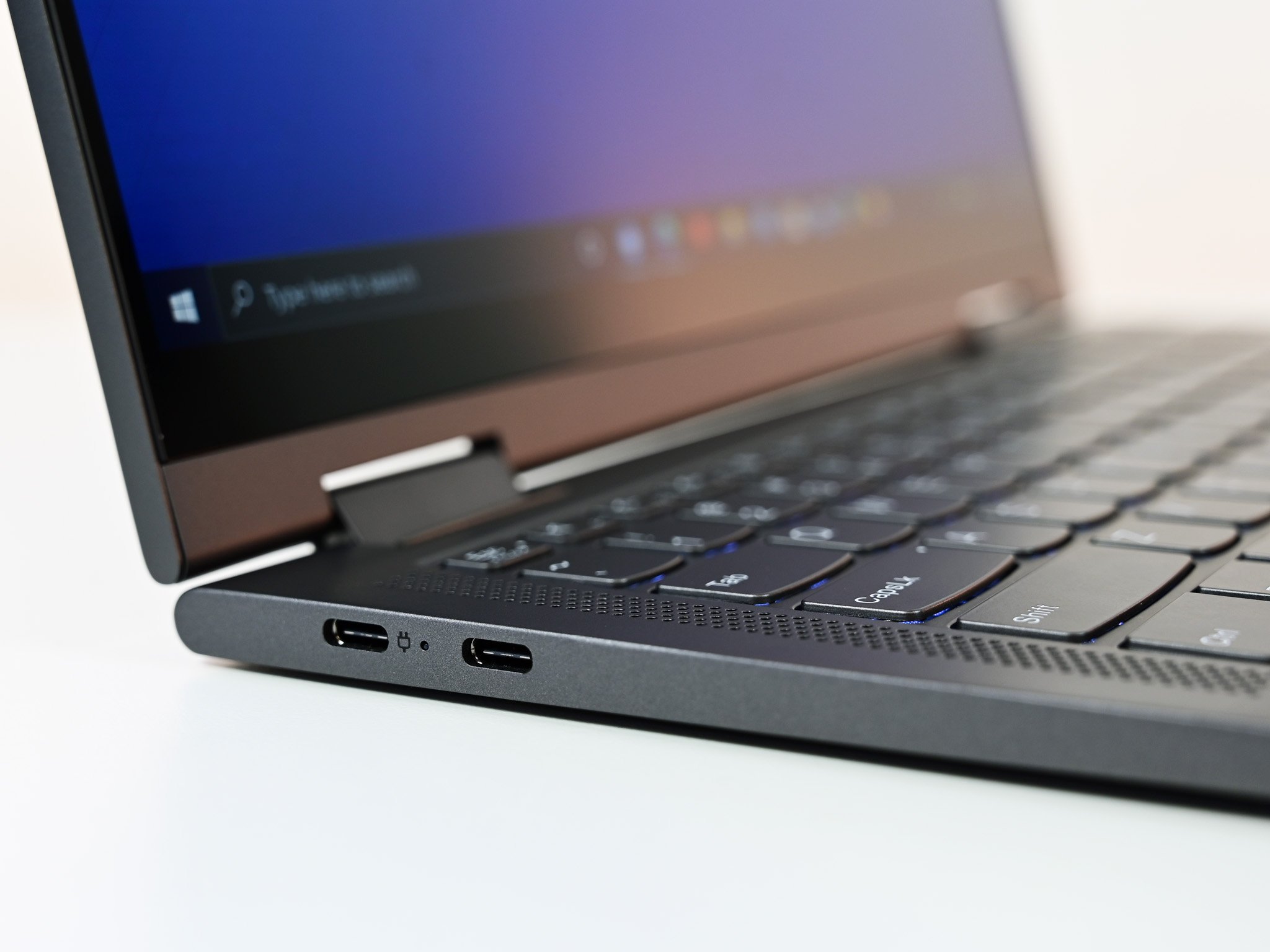
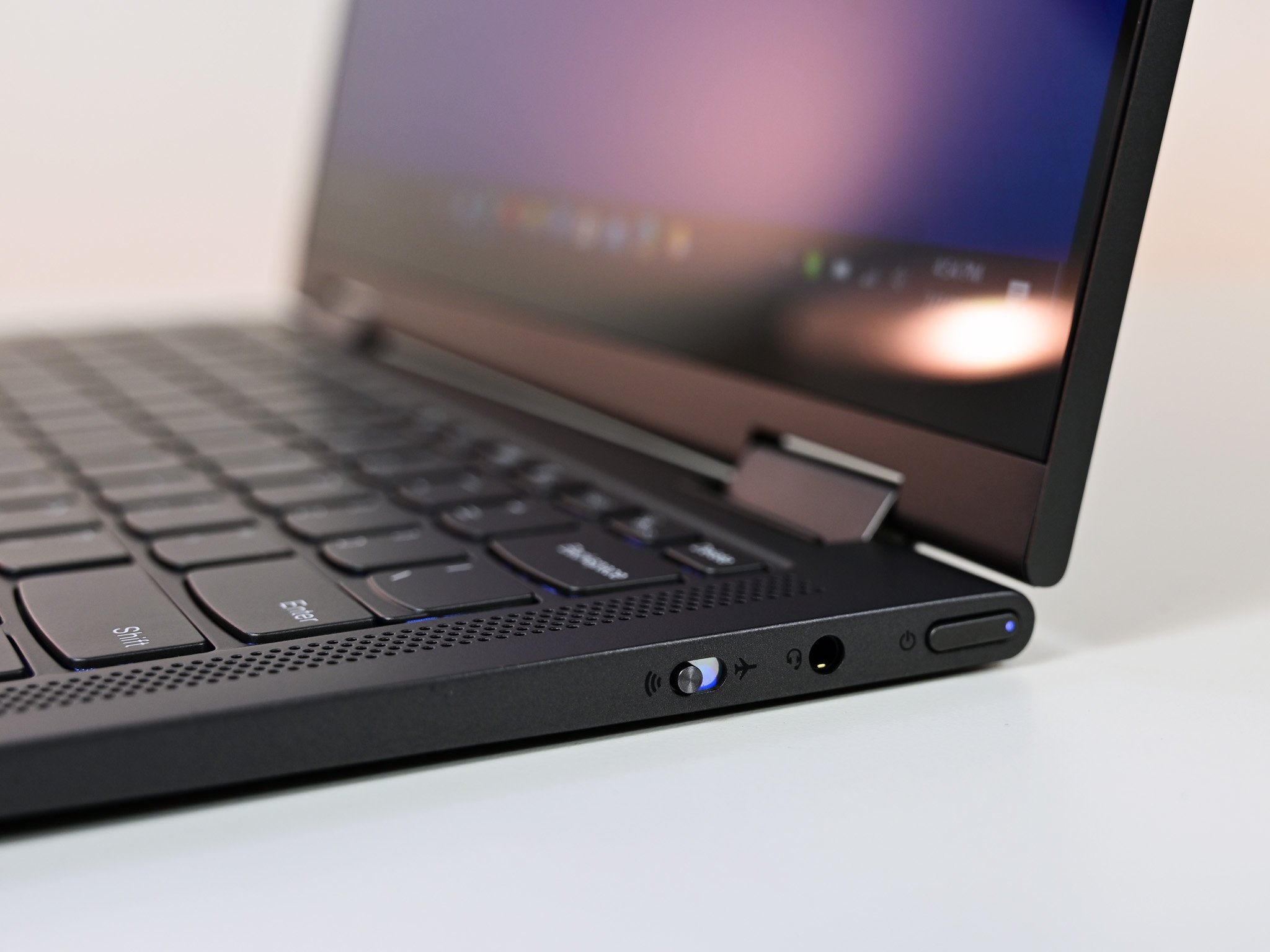
Lenovo calls this "Flex" instead of "Yoga" for various marketing reasons, but the concept is the same. The Flex 5G can act as a regular thin laptop or flip around to become a usable tablet. Toss in some presentation and tent modes, and you have … a flexible PC. Lenovo uses its familiar dual-hinge design, and the laptop can be opened with one hand.
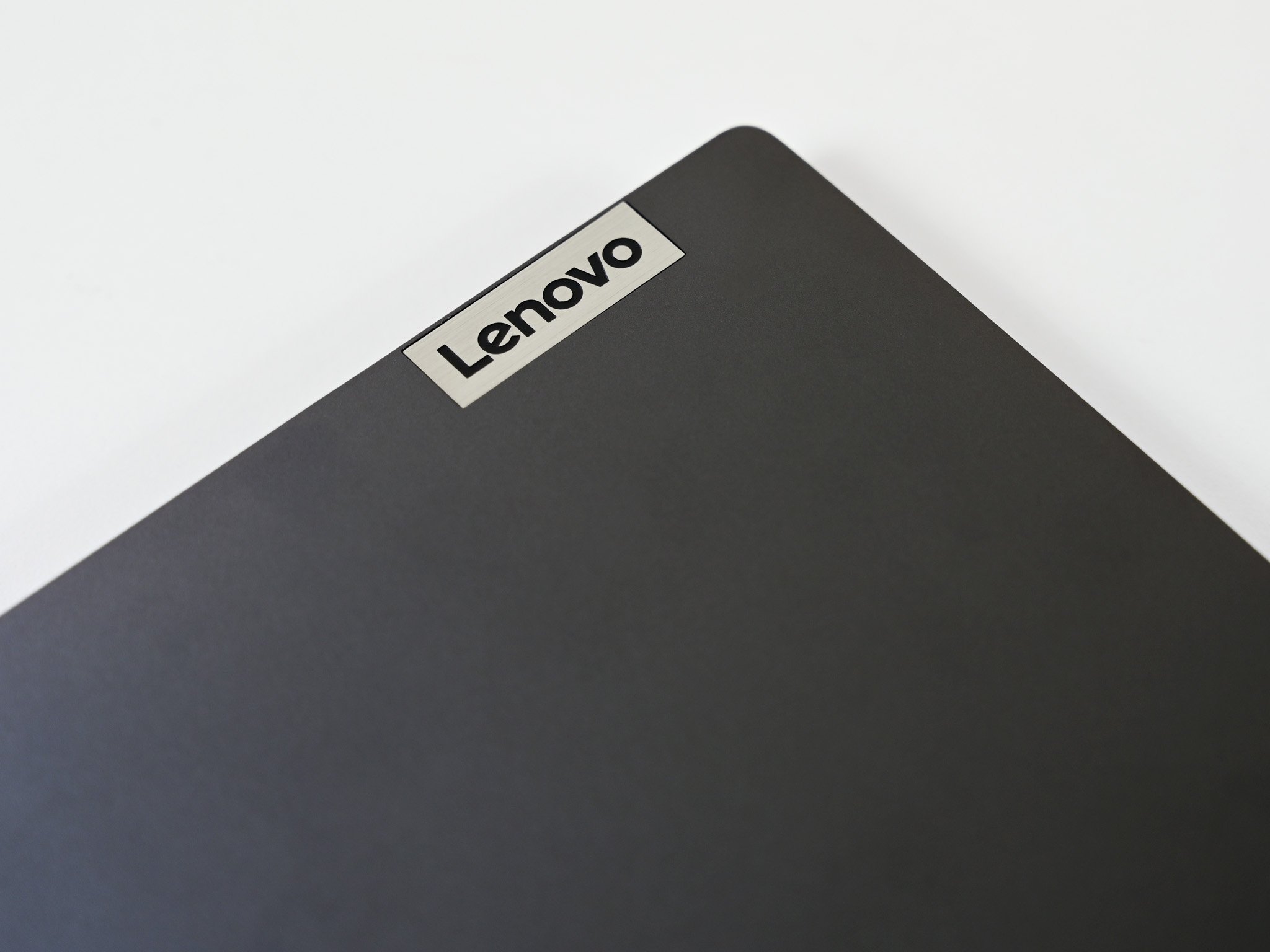
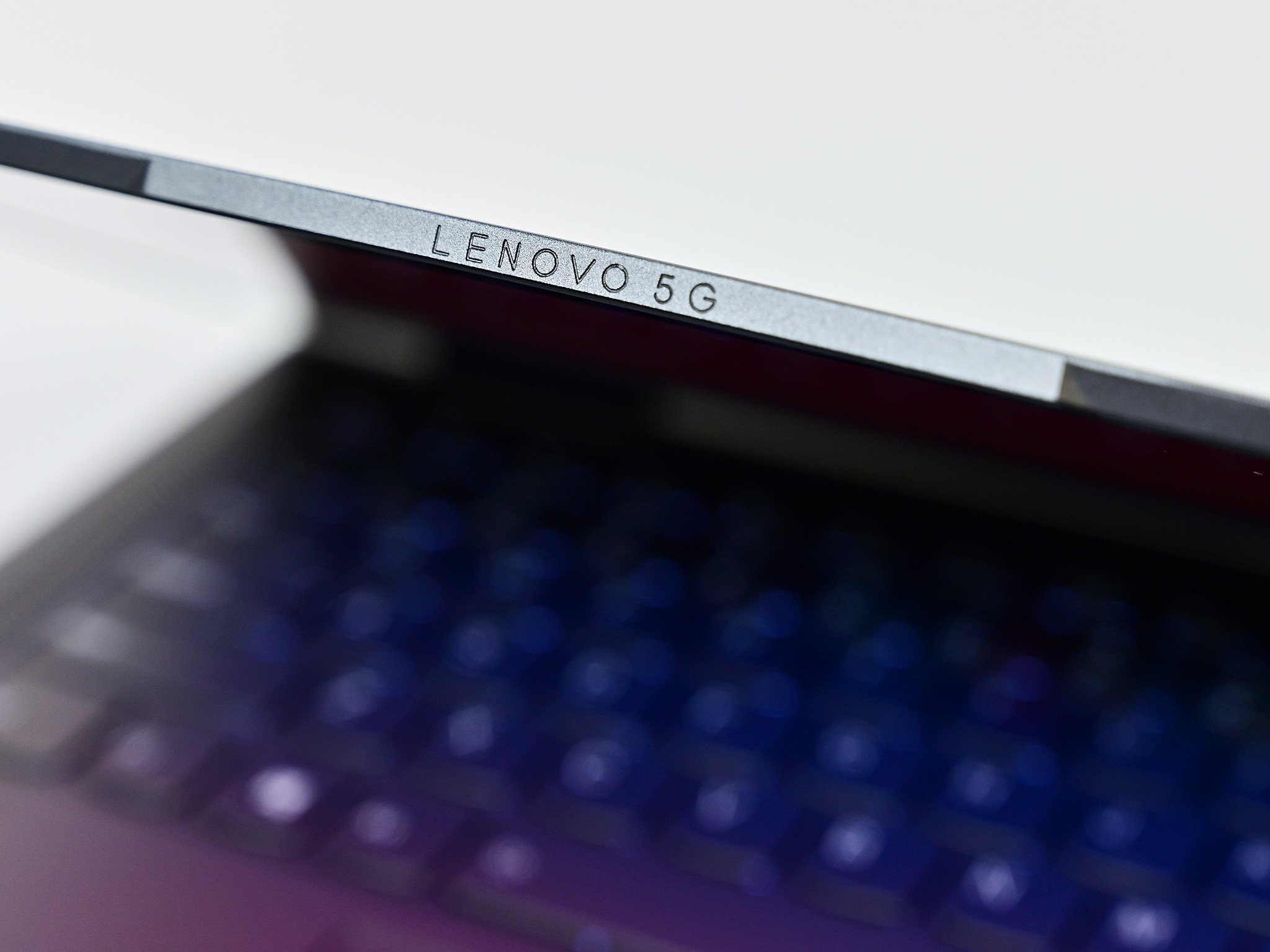
For the exterior, the Flex 5G features an aluminum-magnesium chassis that is wrapped in an inviting "iron grey" soft-touch layer. The body is firm with little flex and feels high quality without also being fragile. Lenovo earns praise for its beautifully minimalist design chic, especially with the tasteful Lenovo metal badge. In a sea of laptops that put the logo center on the back of the display, Lenovo's choice stands out and is frankly more beautiful looking.
However, some may not appreciate the corresponding Lenovo badge on the keyboard deck with Verizon's 5G logo. Still, I think it is a not-so-subtle reminder of why you are buying this laptop in the first place.
| Category | Lenovo Yoga 5G |
|---|---|
| OS | Windows 10 Pro |
| Display | 14-inch FHD (1920 x 1080) IPS with touch 400 nits 72% color gamut |
| Processor | Qualcomm Snapdragon 8cx |
| Graphics | Qualcomm Adreno 680 |
| Memory | 8GB LPDDR4X 1866MHz (Soldered) |
| Storage | 256GB UFS 3.0 |
| Webcam | 720p IR camera |
| Microphone | Dual array |
| Security | IR camera Fingerprint reader |
| Wireless | 5G mmWave 5G Sub-6GHz Bluetooth 5.0 Wi-Fi 11ac (2x2) |
| Ports | 2x Type-C (PD,DP, USB 3.2) 3.5mm Audio jack Nano SIM card slot |
| Audio | User-facing stereo speakers (Dolby Atmos) |
| Battery | 60Whr (7,898mAh) |
| Chassis | Aluminum magnesium |
| Color | Iron Grey |
| Dimensions | 12.65" x 8.46" x 0.57" (321.4mm x 215mm x 14.7mm) |
| Weight | Starting at 1.35kg (2.97lbs) |
For ports, there are no surprises with just two Type-C 3.1 Gen 2 on the left that can be used for charging, data, and display out. There is no Type-A port, but since this PC is just a half-inch thick (14.7mm), it is just too thin to accommodate one.
The Flex 5G does some fantastic stuff, and what it does it does very well.
A new smart addition is the dedicated airplane mode toggle on the right side (near the headphone jack). This physical switch has a nice hologram-like color, which adds a smidge of pizzazz. The toggle lets users kill Wi-Fi and the dual 4G +5G radio to save battery. It is a small extra, but it seems so right for this laptop, and I am glad it's here.
Lenovo puts the power button with a small power LED on the right side near the rear edge. That placement makes it convenient for powering on and off in different configurations. Still, it also means some people may accidentally toggle the power when gripping the Flex 5G to reposition it. I never had that happen, but it is why some manufacturers have returned to placement on the keyboard deck. There's another small LED on the left side near the Type-C port used for charging and battery status. That LED can blink orange when low on battery and also let users know the device is charging (solid white LED, instead of blinking) while the Flex 5G's lid is closed.


Besides the infra-red lens for Windows Hello facial recognition (another significant improvement over the Yoga C630), there is a secondary fingerprint reader on the top deck. Both options for biometric logging in worked without a hitch. The Flex 5G is one of the quickest instant-on Windows PCs to date.
At 2.97 pounds (1.35kg), it is difficult to call the Flex 5G light especially compared to the super-skinny Galaxy Book S (2.1lbs, or 0.96 kg). But Lenovo's extra weight has a justification: battery. Microsoft and Samsung prioritized slimness while sacrificing battery capacity (38 and 42 watt-hours, respectively), whereas Lenovo tossed in a massive 60 watt-hours into Flex 5G.
An improved display
Lenovo Flex 5G display and inking

Lenovo is now using a larger 14-inch full HD display instead of the previous 13.3-inch found in the Yoga C630. While it's still oddly 16:9 (instead of preferred 16:10), this screen is a massive improvement over the Yoga C630's, which suffered from a cheap yellowing of whites. The 14-inch size is much more practical, delivering a noticeable difference in usable space. Colors and contrast are excellent, making this one great looking screen.
The panel also hits around 400-nits for brightness, which is decent (and improved). But Samsung's similar Galaxy Book S has an "outdoor mode" that can boost the brightness to 600 nits, which is something Lenovo should adopt. What makes things worse is Lenovo's insistence on using a very glossy display instead of either matte or the superior glossy with anti-reflective coating. This complaint may seem like nitpicking, but for a computer that you can use anywhere at any time, it's sure a challenge to use in the bright outdoors.
There is some aggressive adapative contrast. While that feature is useful for the battery and your eyes, it does reduce the visibility of dark backgrounds even more so when outdoors. Unlike Intel-based laptops, it is not obvious how you can disable the "feature."
There is no adaptive brightness on this laptop, so users will need to set how bright the screen gets manually.
The Flex 5G supports Windows Ink via Lenovo's Digital Pen, which is an extra $32. Inking also works with the dual-protocol Bamboo Ink. Like the Yoga C630, inking is just OK on this PC. It gets the job done for notetaking, highlighting, and quick sketches, but the lack of precision and accuracy do not make the Flex 5G suitable for dedicated artistry.
Shallow, but OK
Lenovo Flex 5G keyboard, audio, and trackpad
The keyboard on the Flex 5G is a bit of a mixed bag. Lenovo has well-designed keycaps here that are tactical and look great, but the travel is quite low compared to other laptops. It's not dissimilar to the Galaxy Book S and is a smidge deeper, but there is still some adjustment needed. Lenovo is going for a thin profile and a lot of battery, which means less key travel.
I had no problems typing in my use, but Michael Fisher (aka MrMobile) did report dropping some keystrokes, which I find plausible due to the low key travel.
There is two-stage backlighting controlled by the FN key plus spacebar, which is familiar to Lenovo. Thanks to the dark background, the LED lighting works well and is visible at night.

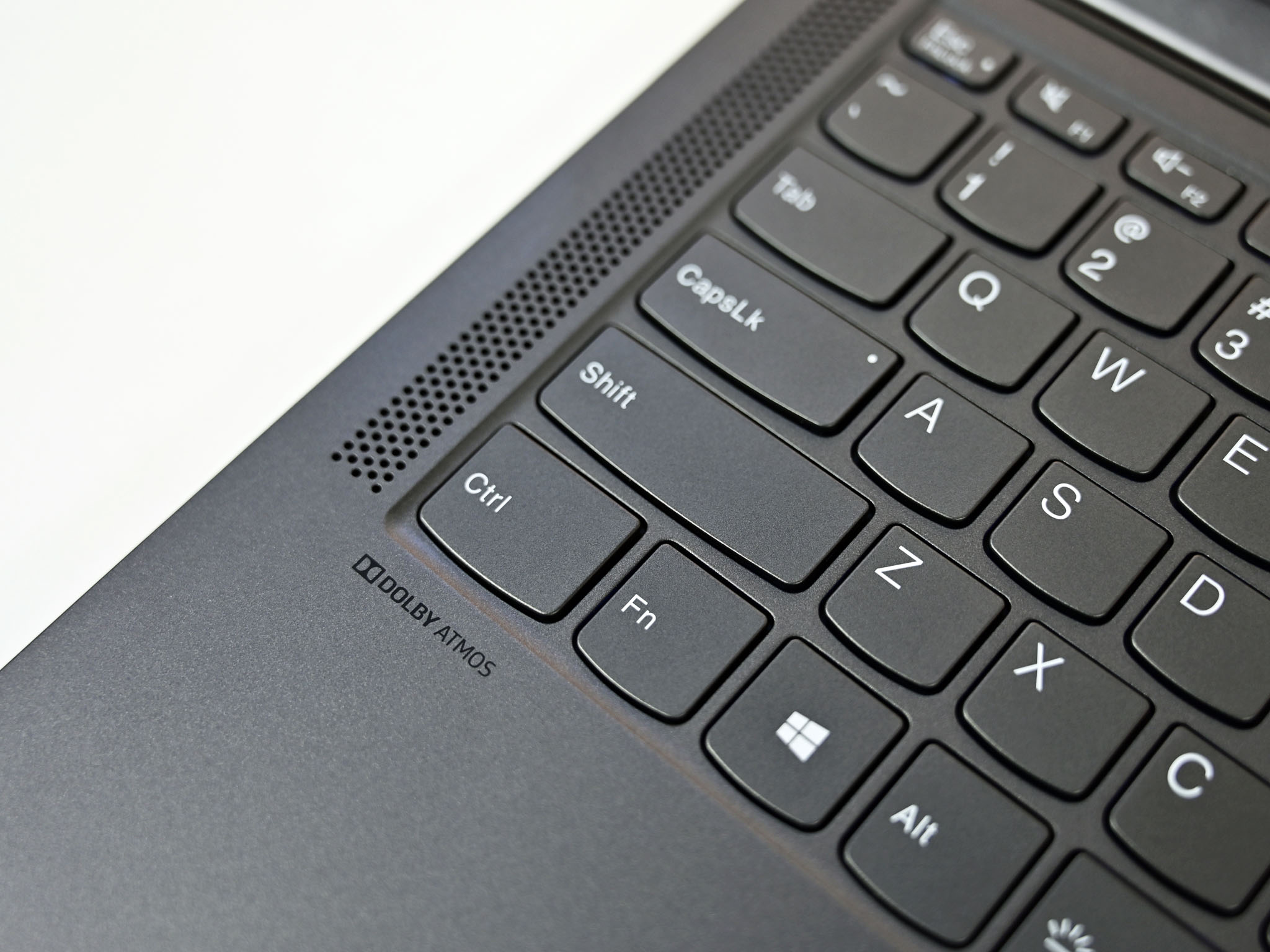
The trackpad is quite large, smooth, and it has a very even click. Lenovo is, unsurprisingly, using Microsoft Precision drivers, and I rate this trackpad as exceptionally good.
Audio is also just OK. Lenovo is rightly using top-firing speakers, which flank the keyboard. New this year is support for Dolby Atmos, which via software provides better spatial abilities giving a bit more presence. Unfortunately, the audio still lacks bass and richness compared to other premium laptops. It is not bad, but it is still far from exceptional.
Now that's fast
Lenovo Flex 5G Wi-Fi, LTE, and 5G performance
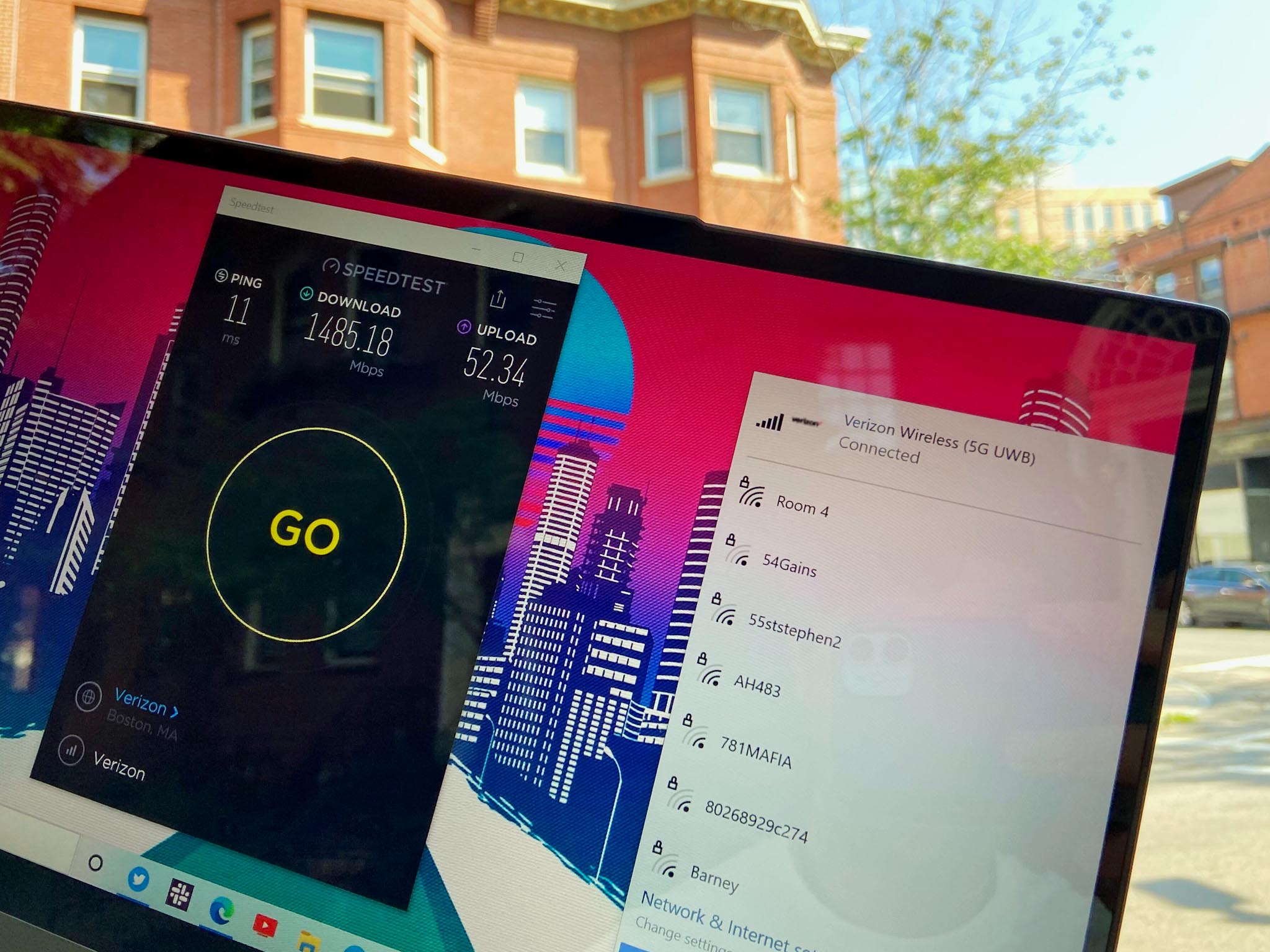
The Flex 5G has a physical Nano-SIM slot on the rear lower-half to add 4G or 5G wireless connectivity. There is also support for a secondary eSIM (electronic SIM) ability where users can buy data through Microsoft's app, or users can add an eSIM provided through a carrier.
These are some crazy fast data speeds...so long as you can actually find 5G coverage.
While there is some branding of Verizon Wireless for the Flex 5G, including a partnership to sell them online, the Flex 5G is carrier-unlocked and supports all 4G and 5G networks. That means you can drop in a T-mobile, Sprint, or AT&T SIM and get whatever performance those services offer, including up to 5G. The Flex 5G also supports all global bands, and users should have no problems connecting to any world carrier.

4G LTE performance is very good, thanks to the aggressive antenna array needed for 5G. Compared to Intel-based laptops with an LTE modem, the Flex 5G is always connected. I never at a single issue with it connecting to a network (unlike the HP Elite Dragonfly, which often had modem issues).
5G support here includes both mmWave and Sub-6GHz, which is excellent. While mmWave is much faster than Sub-6GHz, it is also more prone to stability issues and interference from physical objects, including windows. Sub-6GHz is less impressive, and only offers around 20% improvement over current 4G LTE, but it is more widely deployed.
With the Flex 5G, the good news is you don't need to worry about these terms as the laptop connects to whatever is available and provided through your chosen carrier.
For this review, I had to drive an hour to get to a market (Boston) with Verizon 5G availability, which tells you a lot about the current state of the technology.
The reach of Verizon 5G ultrawideband (UWB) is sparse at the moment, but where it is available it delivers impressive, albeit inconsistent speeds. It's not uncommon to see 1,700 Mbps for download with 10ms pings. Such rates let me download Starship Troopers (1997) in full HD from Netflix in precisely four and a half minutes. Those numbers can dramatically shift when moving, but even at its worst rates, it's still in the hundreds of megabits per second speed, making it vastly faster than 4G.
Upload speeds, however, are less impressive at around 60 Mbps. That's still a massive jump from 4G LTE, and it easily beats the upload rates of many people's home (and wired) cable internet.
Bluetooth 5.0 is here as well, which is expected on any premium PC in 2020. It works well, and I had no issues with it. However, Qualcomm-based laptops are still using Wi-Fi 5 (11ac) instead of the preferred Wi-Fi 6 (11ax) standard. Intel is the biggest pusher of Wi-Fi 6 mobile chips, so there is likely some politics in play as to why the Flex 5G omits the tech, which is unfortunate.
Endless battery
Lenovo Flex 5G power, battery, and performance
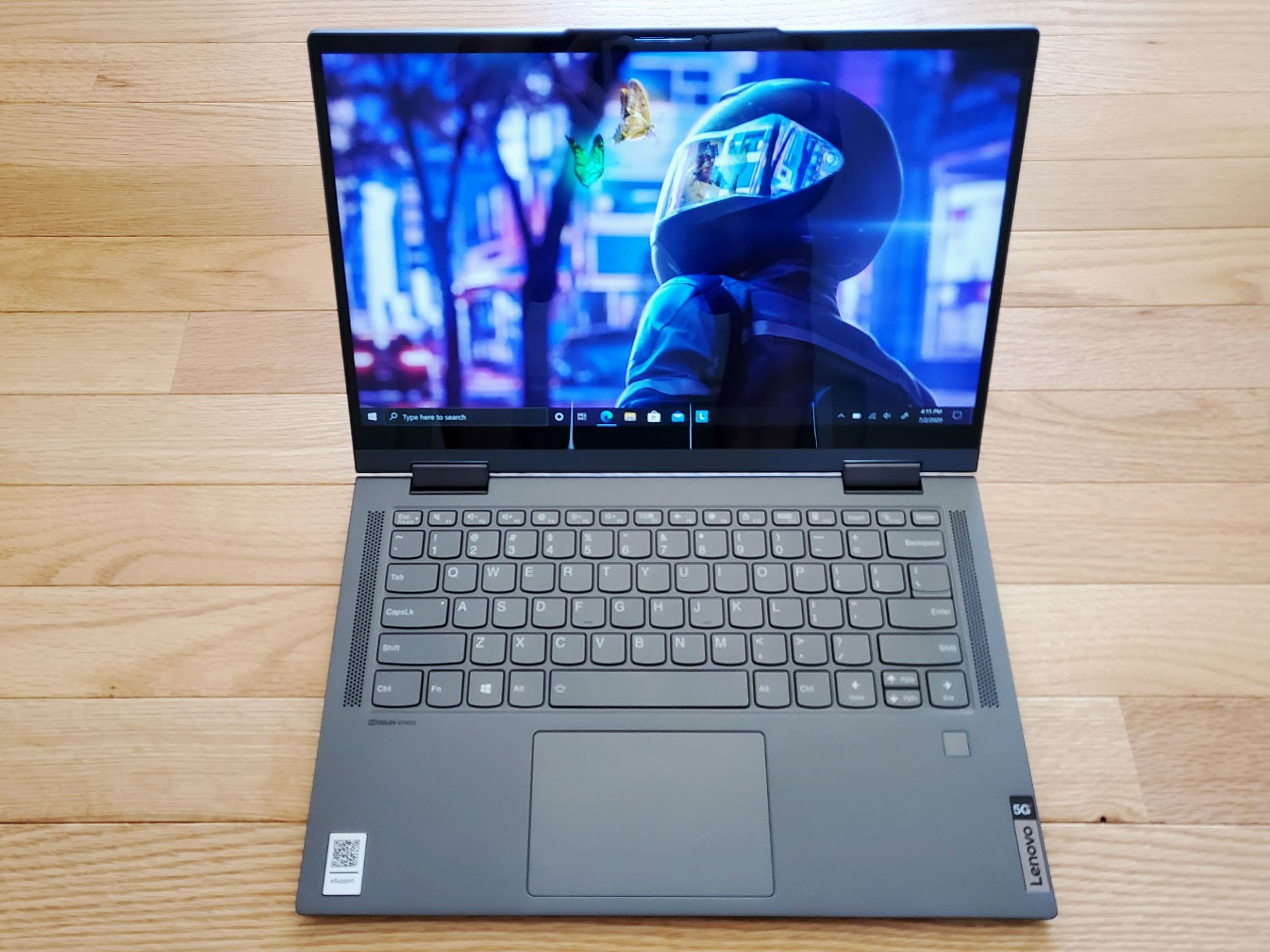
Although the Flex 5G is one of the more massive Windows 10 on ARM laptops nearing 3 pounds, it at least pays off with battery life. Lenovo makes some bold claims of 20 or more hours of usage, but realistically it is a minimum of at least nine hours with everything set to max. It's not uncommon, however, to routinely hit 12 or more hours, which is incredible. That's real usage with 4G LTE on and display brightness up high.
Using PCMark 10 synthetic battery test, which attempts to run down the processor to 20% while running office apps, web browser, and video calls demonstrate just how much more battery the Flex 5G packs:
PCMark 10 Battery (Applications)
| Device | Time | Battery |
|---|---|---|
| Flex 5G | 18 hours | 20% left |
| Galaxy Book S | 11 hours, 11 mins | 21% left |
| Surface Pro X | 8 hours, 31 minutes | 20% left |
There are no Intel-based laptops with 4G LTE that can claim the same (not without an extra half-pound of weight), let alone ones having 5G. When combined with the instant-on abilities, this laptop gets excellent battery life, but it also means you never have to wait for it to turn on as it behaves exactly like your smartphone.
Oddly, however, the Flex 5G has absolutely no way to hibernate. The Surface Pro X goes to a deep hibernate after a few hours, helping preserve battery life (at the cost of having to resume). Of course, users can override that feature on Surface Pro X or make the timeout feature longer. But on the Flex 5G, even under custom advanced power settings, there is no option for hibernating at all, and it cannot be added. That means the Flex 5G never turns off unless you power it down or the battery dies. In some ways, it is fine since the battery longevity here is so extended, but it also means if left unattended for a few days, the Flex 5G's battery will die just like your smartphone.
Geekbench 5
Geekbench 5.0 (CPU) (Higher is better)
| Device | CPU | Single core | Multi core |
|---|---|---|---|
| Flex 5G | SD 8cx | 716 | 2,844 |
| Galaxy Book S | SD 8cx | 685 | 2,681 |
| Surface Pro X | SQ1 | 725 | 2,819 |
| MagicBook 14 | Ryzen 5 3500U | 748 | 2999 |
| Acer Swift 7 | i7-8500Y | 732 | 1,106 |
| Surface Laptop 3 13.5 | i5-1035G7 | 1,177 | 4,413 |
| Surface Laptop 2 | i5-8250U | 909 | 3,372 |
| Surface Pro 7 | i5-1035G4 | 1,191 | 4,441 |
| Surface Pro 6 | i7-8650U | 1,113 | 3,519 |
| Surface Pro 6 | i5-8250U | 904 | 3,440 |
| Dell XPS 13 2-in-1 7390 | i7-1065G7 | 1,209 | 3,571 |
Geekbench 4
Geekbench 4.0 (CPU) (Higher is better)
| Device | CPU | Single core | Multi core |
|---|---|---|---|
| Flex 5G (ARM) | SD 8cx | 3,288 | 11,139 |
| Galaxy Book S (ARM) | SD 8cx | 3,271 | 11,096 |
| Surface Pro X (ARM) | SQ1 | 3,505 | 11,727 |
| Yoga C630 (ARM) | SD 850 | 2,287 | 7,215 |
| Flex 5G (x86) | SD 8cx | 2,103 | 6,681 |
| Galaxy Book S (x86) | SD 8cx | 2,032 | 6,371 |
| Surface Pro X (x86) | SQ1 | 2,182 | 6,822 |
| Yoga C630 (x86) | SD 850 | 1,345 | 3,560 |
| Acer Swift 7 | i7-8500Y | 2,281 | 4,905 |
| Samsung Galaxy Book2 (ARM) | SD850 | 2,262 | 7,405 |
| Samsung Galaxy Book2 (x86) | SD850 | 1,345 | 4,164 |
| HP Envy x2 (ARM) | SD835 | 2,111 | 6,314 |
| Surface Go | Pentium | 2,078 | 3,934 |
| Surface 3 | Atom x7 | 1,078 | 2,777 |
| Surface Laptop 3 13.5 | i5-1035G7 | 5,265 | 17,345 |
| Surface Laptop 2 | i5-8250U | 4,203 | 13,233 |
| Surface Laptop | i5-7200U | 3,725 | 7,523 |
| Dell XPS 13 2-in-1 7390 | i7-1065G7 | 5,459 | 19,097 |
PCMark 10
Applications (Higher is better)
| Device | CPU | Score |
|---|---|---|
| Flex 5G | SD 8cx | 5,026 |
| Galaxy Book S | SD 8cx | 4,308 |
| Surface Pro X | Microsoft SQ1 | 4,617 |
SSD
CrystalDiskMark (Higher is better)
| Device | Read | Write |
|---|---|---|
| Flex 5G | 1,913 MB/s | 426 MB/s |
| Galaxy Book S | 1,912 MB/s | 425 MB/s |
| Surface Pro X | 2,023 MB/s | 832 MB/s |
| Yoga c630 | 791 MB/s | 220 MB/s |
| Samsung Galaxy Book2 | 722 MB/s | 205 MB/s |
| HP Envy x2 | 513 MB/s | 197 MB/s |
| Surface Go (SSD) | 1,185 MB/s | 133 MB/s |
| Surface Go (eMMC) | 260 MB/s | 145 MB/s |
| Surface 3 | 149 MB/s | 33 MB/s |
| Surface Laptop 3 13.5 | 2,338 MB/s | 1,583 MB/s |
| Surface Laptop 3 15 | 2,028 MB/s | 806 MB/s |
| Surface Laptop 2 | 1,509 MB/s | 811 MB/s |
| Surface Laptop | 486 MB/s | 244 MB/s |
| Dell XPS 13 2-in-1 7390 | 2,400 MB/s | 1,228 MB/s |
.
Performance is quite good and the Flex 5G is the fastest instantiation of Windows on ARM yet (see PCMark 10). While Surface Pro X is technically more potent on paper (thanks to its 3.0GHz Qualcomm processor, instead of the 2.85GHz of the Flex 5G), it does not show up in benchmarks, nor can you noticed the difference side by side. Surface Pro X also has a stronger GPU, but it is not clear that users will see the difference in day to day productivity. I did not.
For fans of Windows on ARM, or the idea of an always-connected PC the Flex 5G is one of the best implementations of the technology yet.
Comparatively, the Snapdragon 8cx is similar to the AMD Ryzen 5 3500U, which is still used in many mid-range laptops. The 8cx also comfortably beats the older, but low-powered, Intel dual-core Core i7-8500Y.
SSD performance is also in the expected range with the 256GB UFS 3.0 drive (bumped from UFC 2.1). Just shy of 2,000 MB/s for sequential read and 500 MB/s for writing is like the Galaxy Book S but lags behind Surface Pro X.
While there is still some confusion over what Windows 10 on ARM can do, for this class of device, and my workload, I had no issues with day to day activities. Here is a sample of the apps and programs that I use on a laptop like the Flex 5G:
- Microsoft Office (Word, OneNote, Excel)
- Microsoft Edge (ARM64)
- Hulu
- Netflix
- Spotify
- VUDU
- Disney+
- Microsoft Teams
- Slack
- Mail (Outlook.com)
- Flow Mail (Gmail)
- Polarr Photo Editor Pro
- Microsoft News
- GroupMe
- OneDrive
- Skype
- Microsoft To Do
- myTube! (YouTube)
- MobileDiscord PTB (Discord)
- Unigram (Telegram)
- ExpressVPN using manual configuration
However, another odd bug is when the Flex 5G hits less than 20% of battery life. The Snapdragon 8cx comes to a crawl, which is very noticeable. This drop in performance is demonstratable in Geekbench 5, which saw a steep decline in single-core speed (147 versus 716). It's easy to ascribe such behavior to "battery saver mode," but this is not the case as the performance drop occurs even when plugged in and using the included 45-watt Type-C charger. That should not happen.
Because of the fanless and ventless design of the Flex 5G (and the Snapdragon processor), there is effectively no heat or thermals to report. The Flex 5G is entirely silent and never gets hot.
Anything similar?
Let's talk about the competition
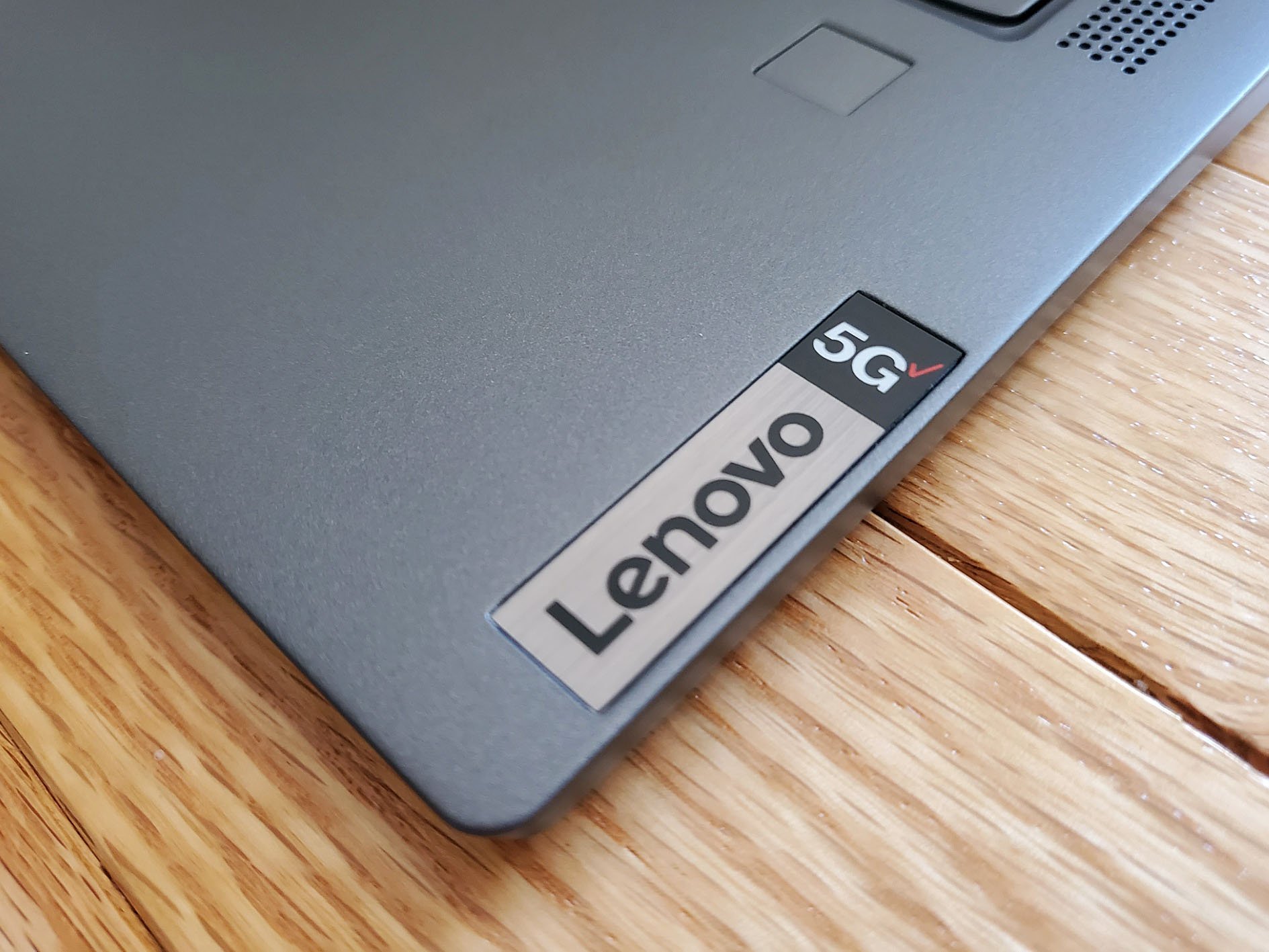
The one prominent defining feature of the Flex 5G is, well, the 5G ability. As of this review, there is no competition in this space. HP is expected to have a 5G-enabled Elite Dragonfly (see our review of the non-5G version) later this summer. So is Dell with the new Latitude 9510. Both laptops, however, will run at least hundreds of dollars more than the $1,400 price for the Flex 5G, and they won't have the same battery life or instant-on abilities. Conversely, they won't have the limits of ARM64 since they rely on Intel x86, making the higher cost worthwhile for some buyers.
In other words, while not cheap, the Flex 5G may end up being the most affordable 5G-enabled laptop for the foreseeable future.
Samsung's new Galaxy Book S is a natural competitor to the Flex 5G except for the fact it is only 4G LTE capable. But at $999, it is $400 cheaper than the Flex 5G and delivers a similar experience. Unfortunately, Book S is a non-convertible laptop, which means while it does have a touch screen, it is less capable than the Flex 5G and it does not support inking at all. It also gets significantly less battery life compared to the Flex 5G and has a slightly worse keyboard, but it is thinner and nearly a pound lighter.
Microsoft's Surface Pro X is also another excellent always-connected candidate. It differs from Galaxy Book S and Flex 5G in that it is a tablet-style PC instead of a clamshell convertible laptop. The Pro X is around two hundred dollars cheaper (after including the required Surface Type Cover, and optional pen). It gets worse battery life but has a higher resolution display, excellent inking, particularly good audio, and a unique form factor.
Factoring out 4G and 5G capability, and the competition goes through the roof. There are plenty of modern Ultrabooks that cost less and deliver more performance, but lack the advantages (and disadvantages) of ARM.
Really good, but could be better
Lenovo Flex 5G Should you buy?
Who it's for
- If you absolutely "need" 5G in a laptop
- If you want always-connected with excellent battery life
- If you work mostly on web, office, email, video calls, and information
- If money is NBD
- If you like convertible PCs with OK inking
Who it isn't for
- If you want to game (without streaming)
- If you're looking to stretch your dollar
- If you need 64-bit x86 applications like Adobe Photoshop
The biggest drawback to the Flex 5G is obvious: its $1,400 price. It all comes down to the "tax" levied on by Qualcomm for its 5G compute platform. Companies have invested millions into developing and promoting 5G, so it is not uncommon to see them recoup costs by charging early adopters more money for the privilege. Such an experience is mirrored in current 5G phones, which almost always run a higher price tag unless heavily subsidized by a carrier.
The question is whether getting 5G in a laptop is worth it, which is a personal choice. While there is a lot of hype around 5G, one could convincingly argue that it makes much more sense in a laptop than a phone. You are likely to be more stable for that mmWave 5G versus a phone, and you're likely to need the bandwidth (or least, appreciate it) on a real PC.
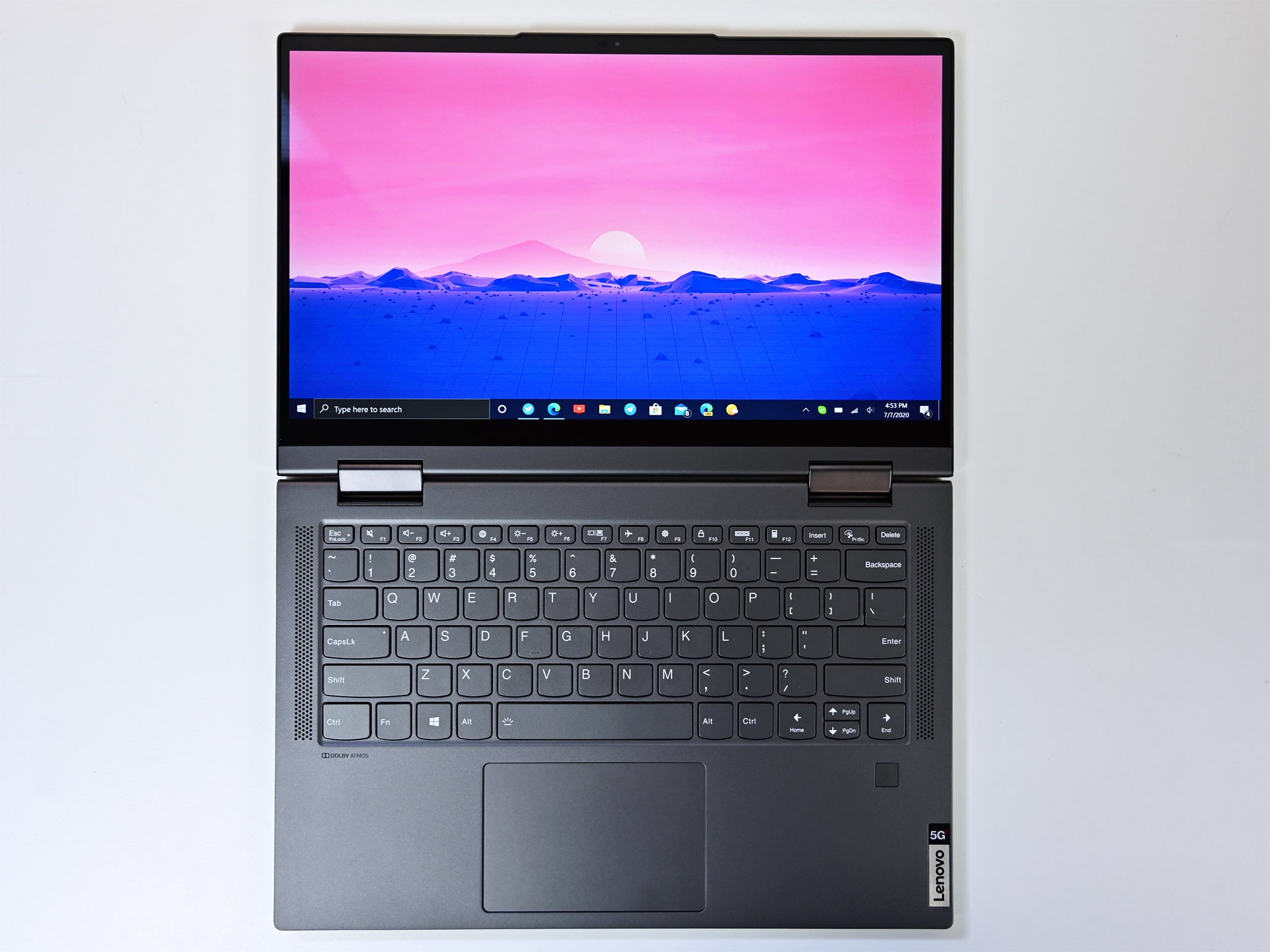
While 5G coverage is lacking for many of us right now, it is also clear that such limitations will go away over the coming years. But then one can assume that even faster 5G-enabled laptops will be around making the Flex 5G a purchase for those with lots of extra income (or business execs). That's fine, as that is a legitimate market, but let's not confuse that with average consumers who won't see much benefit.
While not cheap, the Flex 5G may end up being the most affordable 5G-enabled laptop for the foreseeable future.
For fans of Windows on ARM, or the idea of an always-connected PC, the Flex 5G is one of the best implementations of the technology yet. Performance is excellent, the display here is much better than the Yoga C630, battery life is incredible, and it's just a fun laptop to use.
Some issues like the CPU performance drop when below 20% battery, or the inability to hibernate give me pause in recommending this without caveats. However, both problems are technically solvable through software (or firmware) updates, and depending on how you use the Flex 5G may not even be noticeable.
The Flex 5G does some fantastic stuff, and what it does it does very well. It delivers high-speed internet, a battery that lasts for days, excellent performance, and is an overall reliable productivity laptop. But its high price, some early bugs, and glossy display all hurt what is otherwise a significant advancement of the Windows on ARM initiative.
Availability for the Flex 5G is currently in the US-only, but Lenovo will sell it in other markets, including the UK, with EE partnerships this year. The laptop can be purchased directly from Lenovo, or Verizon Wireless with the latter knocking of $100 (1,400 vs. $1,500 from Lenovo).
Overall, it's nice to see a "win" for ARM processing on Windows PCs by being the first to new technology. While we can debate the novelty of 5G, it is impressive to have it this early on a Windows 10 PC. Even without the 5G ability, Flex 5G is an outstanding productivity-focused light computing laptop that will benefit travelers and executives once the world resumes to normal.

Daniel Rubino is the Editor-in-chief of Windows Central. He is also the head reviewer, podcast co-host, and analyst. He has been covering Microsoft since 2007 when this site was called WMExperts (and later Windows Phone Central). His interests include Windows, laptops, next-gen computing, and wearable tech. He has reviewed laptops for over 10 years and is particularly fond of 2-in-1 convertibles, Arm64 processors, new form factors, and thin-and-light PCs. Before all this tech stuff, he worked on a Ph.D. in linguistics, performed polysomnographs in NYC, and was a motion-picture operator for 17 years.
